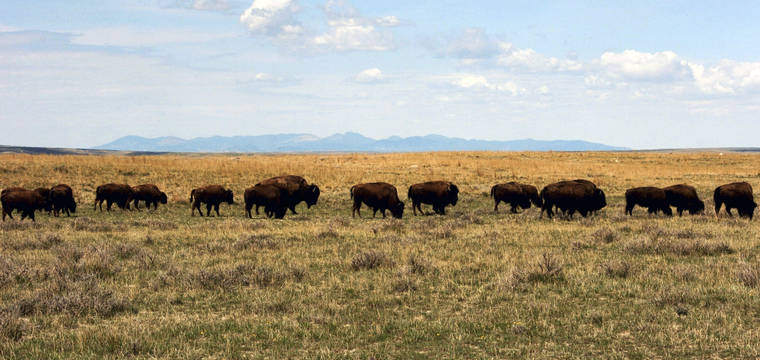HELENA, Mont. — The Democratic governor of Montana who is running for president and the Republican secretary of state who wants his job are locked in a constitutional dispute over a uniquely Western issue that lies at the intersection of politics, wildlife, agriculture and property rights.
The argument between Gov. Steve Bullock and Secretary of State Corey Stapleton could hamper plans to build a sanctuary where thousands of buffalo would roam. It has escalated into a legal battle over whether Stapleton has the power to overrule Bullock’s veto of state legislation because the governor failed to meet a deadline that may or may not exist. A judge was to hear arguments in the case Wednesday.
Bullock is one of nearly two dozen contenders trying to stand out in the Democratic presidential field, while Stapleton is part of a crowded GOP primary race for governor. Their fight centers on an effort to change the state’s legal definition of “wild bison.”
Some Republican lawmakers say the changes are necessary to close gaps in the law. The measure has support from ranchers and landowners, including the United Property Owners of Montana, who worry that an expansion of bison rangeland would increase the risk of disease to their livestock and damage to their property.
Democratic opponents fear the changes would, at best, create confusion over the status of bison living in Yellowstone National Park, the National Bison Range and with tribes, or, at worst, snuff out any hopes that wild bison will again roam freely in the state outside of Yellowstone.
They also say the measure targets a conservation group that is acquiring land in central Montana to try to create the nation’s largest private wildlife reserve, which could one day be home to 10,000 bison.
Bozeman-based American Prairie Reserve has raised more than $100 million since 2001, owns about 156 square miles (404 million square kilometers) of land and has grazing leases for a total of 625 square miles (1.6 million square kilometers) north and south of the Missouri River near the Charles M. Russell National Wildlife Refuge.
The group also owns a herd of about 800 bison, and officials would increase the herd to 10,000 bison one day if state regulations change to allow wild bison to roam in Montana.
“We manage our bison herd as livestock, and we’ve said repeatedly we are not looking to establish a wild bison herd,” American Prairie Reserve spokeswoman Beth Saboe said. “However, if the state would be interested in one day changing its laws to do something like that, we would be open to contributing our animals to that effort.”
Opponents say the disputed legislation would prevent that from happening. It would change the definition of wild bison from an animal “that has not been reduced to captivity and is not owned by a person” to one that has never been in captivity, has never been owned by a person and has never been subject to the state’s livestock fee.
Inserting “never” as a condition of captivity and ownership also could affect bison owned by tribes as well as bison in Yellowstone and the National Bison Range that are descendants of animals that were owned as part of a conservation effort to prevent their extinction, opponents said.
American Prairie Reserve officials now pay fees on their bison, meaning that they could not be deemed wild animals in the future under the measure.
The Legislature passed the measure over Democrats’ protests, and Bullock vetoed it on April 29. Stapleton said Bullock missed a 10-day deadline to physically turn in the veto to his office and that the bill became law.
Bullock said no such deadline exists and that he followed the law in issuing the veto. The governor sued on Friday after Stapleton took the first step toward publishing the legislation into law.
A judge issued a temporary restraining order blocking Stapleton. District Judge Mike McMahon will hear arguments Wednesday on whether to lift that restraining order.


